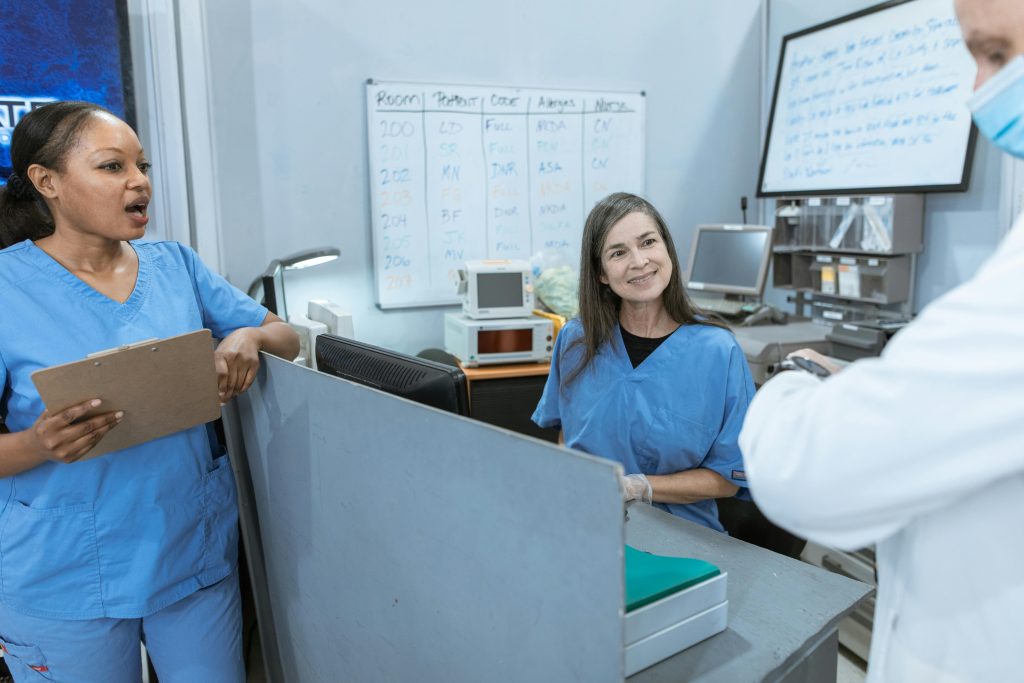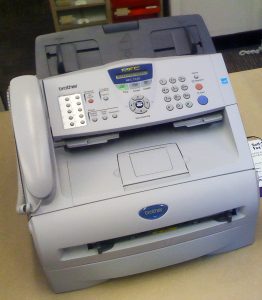Chapter 5: Hospital Communication Processes
Other Communication Devices
In addition to the telephone, the HUC will interact daily with a variety of other communication devices on the patient care unit, with the most common outlined below. In addition to these, the unit that they work in may use a variety of other communication devices and tools, such as on-demand interpretation services and augmentative and alternative communication devices, such as picture boards, iPads, amplifiers, and apps.
Overhead Paging Systems
In addition to hospital-wide overhead paging systems used by switchboards, each hospital department also has its own intercom or overhead paging system to make localized announcements. Unit intercom systems are located at the communication centre and may be stand-alone units, or part of a patient call bell system.
The HUC typically uses the unit intercom to locate staff or call staff to the desk to answer a telephone call. Unit intercom systems may have several different zones, for example, the break room, conference room or med room.
When paging, the HUC should consider the following:
- time of day (it would not be appropriate to page a non-urgent page communication overhead during hours that patients typically sleep),
- the zone required (should they page into a specific zone or all zones?),
- the intended staff member, and what they wish them to do, and
- confidentiality-never broadcast patient’s names.
HUCs must also ensure to speak clearly and repeat important information in the page. For example: “Giovanni, pick up on line 2, Giovanni, line 2.”
Practice Activity: Overhead Paging
Call Bell System
The unit’s call bell system, another type of intercom, allows remote communication with patients. Each bed has its own unit and a button or cord that the patient can press or pull to alert the staff that they require assistance. When the bell is activated, it triggers a light and an audible alarm outside the patient’s room and at the communication station, indicating that the patient needs help. This signal will remain active until manually deactivated by staff in the room or at the desk.
The HUC may be required to respond to call bells, especially during times when the unit is short-staffed or during shift change. If the HUC does respond, they should:
- Identify themselves. For example, “Hello, this is Rashida at the desk, how may I help you?”
- Ask for specifics of what they need.
- Reassure them that you will relay this information to the appropriate person. For example, “I will let your nurse Joseph know that you are asking for pain medication. He will be in as soon as he can.”
After answering the call bell, it is imperative that the HUC passes on the message immediately to the appropriate staff member as missed messages may cause the patient to suffer needlessly for an extended time. If the request is something that the HUC can handle on their own, such as getting more ice, or another blanket, they may do so or ask any member of the staff to assist.
Practice Activity: Call Bells
As the HUC at the desk, you may need to answer call bells when no clinical staff is around. Formulate an appropriate answer to each of the following calls. Remember to answer each “bell” professionally:
Patient #1: I really need something for pain.
Patient #2: (angrily) I have been waiting for half an hour for someone to take me to the bathroom. If someone doesn’t come now, I am going to wet my bed!
Patient #3: Do you know when my doctor is coming in to see me?
Pagers
Many hospitals provide “restaurant-style” pagers to family members waiting for a loved one in surgery or undergoing procedures. This allows families to be relocated outside of the immediate surgical department, freeing up space for other patients and families to receive pre and postoperative care and allowing waiting family members to move freely around the hospital. The HUC would be responsible for recording the pager number and activating it when the patient has completed their procedure and the family is allowed back to the surgical area to wait while they recuperate or for pick up.
Patient Tracking Systems
Patient tracking systems help improve communications and the availability of up-to-date patient information for both staff and families. One of the most common uses for patient tracking systems is for surgical patients.
Surgical patient tracking boards for waiting rooms are designed to provide families with patients’ real-time progress through the surgical procedure through a progress bar that indicates their movement through each area of the surgical procedure. Each patient is represented by a unique identifier (like the PIN number discussed in the previous section) for privacy reasons (Surgical Information Systems, 2023).
Bed Boards
Hospital bed boards present the current picture of beds for each unit of the hospital. The HUC for each patient care unit is responsible for managing patient flow in their designated unit and for ensuring that the patient flow/admitting department is kept up to date on their unit’s bed status (Thompson, 2018).
The HUC must accurately update their unit bed board with confirmed and pending discharges, completed transfers, and patients in isolation. This information is necessary to provide the bed allocator the most accurate and up-to-date information on bed availability on which to base their admitting decisions.
Communication Boards
Many units have communication boards which record general census information. Communication boards are typically large whiteboards with a printed grid or table, with rows and columns to record the following:
- room number
- patient name
- attending physician/MRP
- the nurse attending to the patient for that shift
- additional information such as discharge date
The HUC is responsible for maintaining the communication board and typically makes several changes to it daily as patients are admitted and discharged.
Changes to privacy legislation have necessitated changes to the use of communication boards, with many hospitals now positioning them away from the public, omitting patient names, or using initials or other non-identifying information.

Fax Machines

A fax machine is a telecommunication device that transmits copies of written material wirelessly or over a telephone wire from one site to another. Faxes are transmitted by placing the document(s) to be sent in the direction indicated on the fax feeder tray, entering the recipient’s fax number, and pushing the send button. The scanner then turns the document into a digital signal that is transferred to the receiving machine where it is decoded to reproduce the original document before printing it (Gillingham & Seibel, 2014).
Despite the use of more advanced medical office equipment, the fax is still used in many health care facilities, including hospitals. In the hospital, the HUC may use a fax machine for the following tasks.
- Order entry process: In hospitals where physicians still use paper-based orders, the HUC must fax all order sheets containing medication orders to the pharmacy department to be reviewed, entered in the electronic MAR, and filled.
- Release of information requests: These forms are signed by the patient and faxed to the information management department at other health care facilities, which in turn will collate, prepare and fax the requested records to the requesting patient unit or the HIM department.
- Booking requests: Requisitions sent from physicians’ offices requesting an appointment for clinical evaluation for their patient (for example, an MRI or CT). OR booking requests may also be sent via fax to the OR Bookings Department.
Best Practices for Using Fax Machines
Using a fax is straightforward; however, there are a few best practices the HUC should keep in mind.
- When sending a fax outside of the hospital, always use a cover sheet, and specify the number of pages the fax includes.
- When receiving a fax, ensure that you have the number of pages noted on the cover page.
- If uncertain whether a fax has been sent, review the fax transmission report which itemizes the date, time, and destination of both outgoing and incoming transmissions.
- When scanning faxed documents into the patient’s EHR, always validate that you have the correct patient by double-checking both the full name and date of birth or by medical record number (MRN).
References
Gillingham, E. A. & Wadsworth Seibel, M. M. (2014). LaFleur Brooks’ health unit coordinating. (7th ed.). Elsevier.
Surgical Information Systems. (2023, March 2). 8 ways an ASC patient tracking system improves facility management.
Thompson, V. D. (2018). Administrative and clinical procedures for the Canadian health professional (4th ed.). Pearson Canada.
Attributions
“A Doctor and Nurses having Conversation” by RDNE Stock project; used under the Pexels license.
“Setting up a new fax machine” by Elliott Plack on flicker, Creative Commons – Attribution-Sharealike 2.0 Generic.
responsible for the placement, transfer, and discharge of all inpatients, emergency patients, and patient transfers according to priority and preferred accommodation status; often works closely with a RN (or patient flow manager) in their duties.

